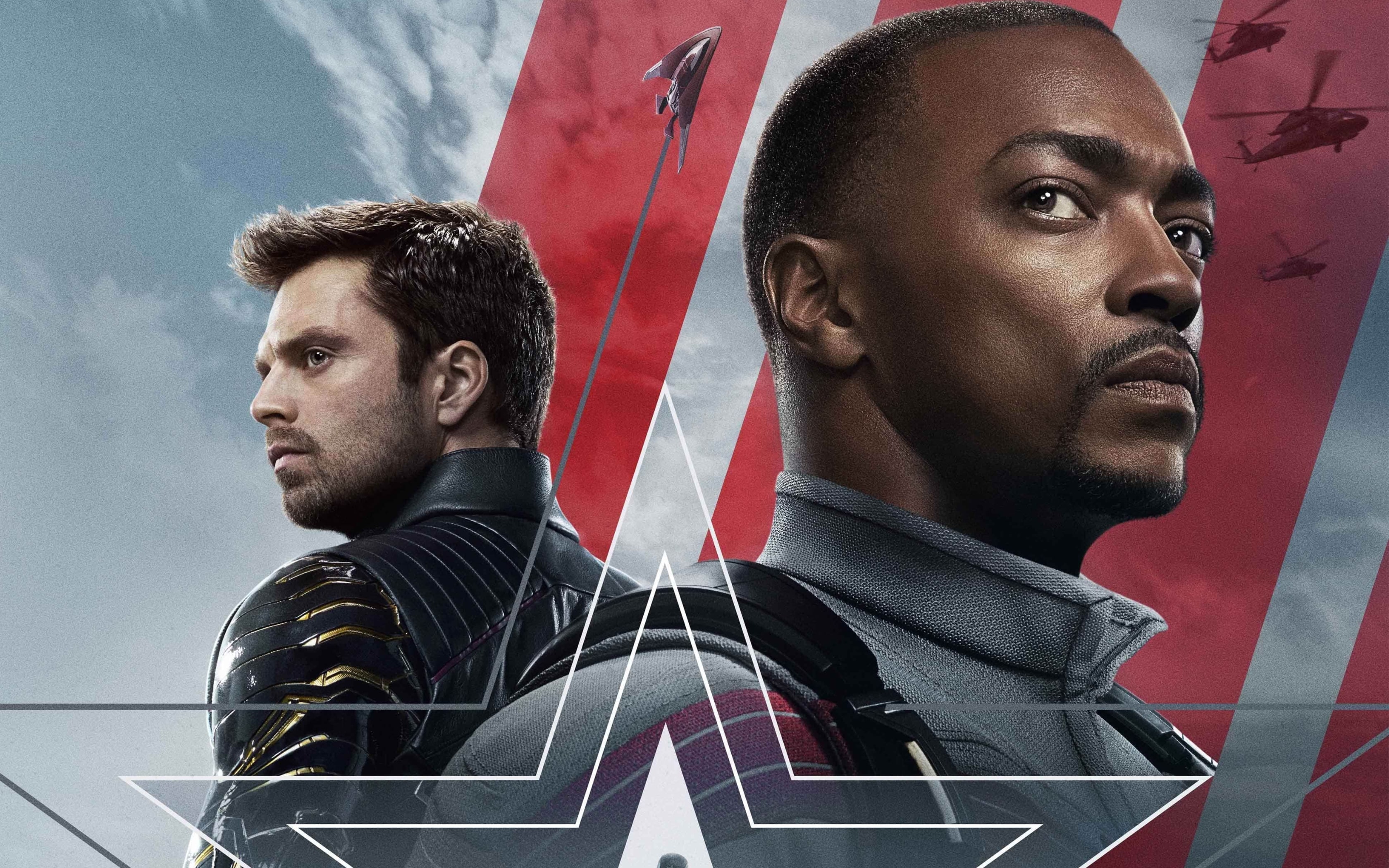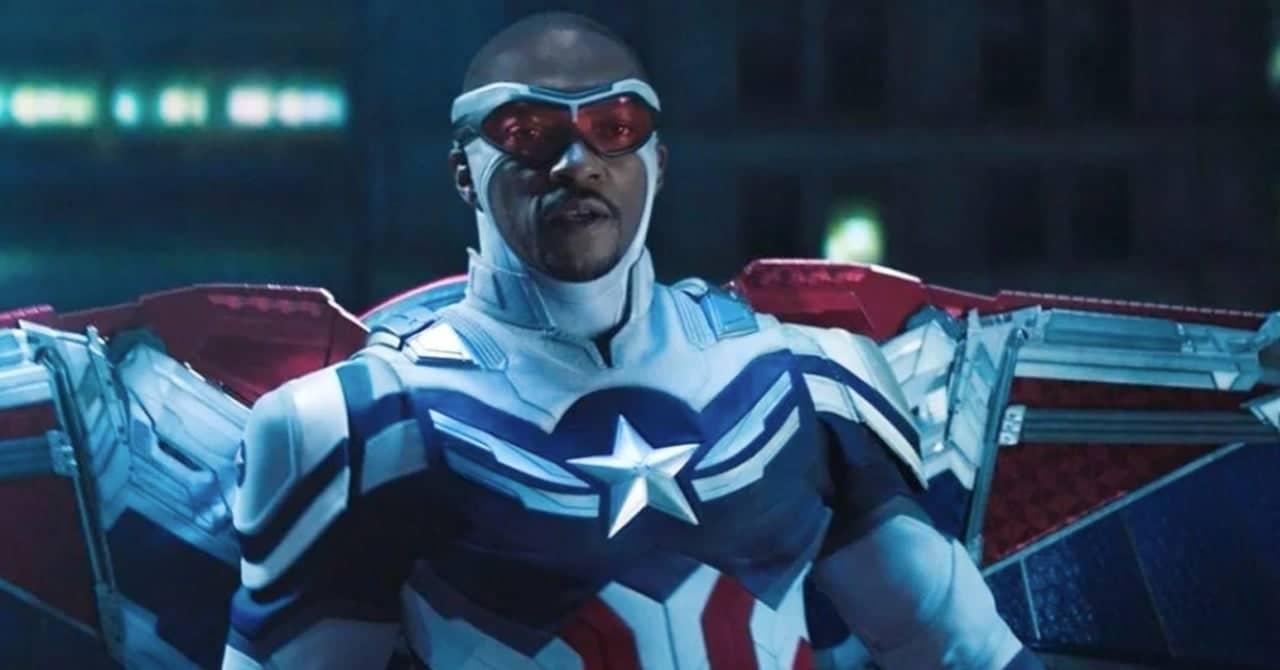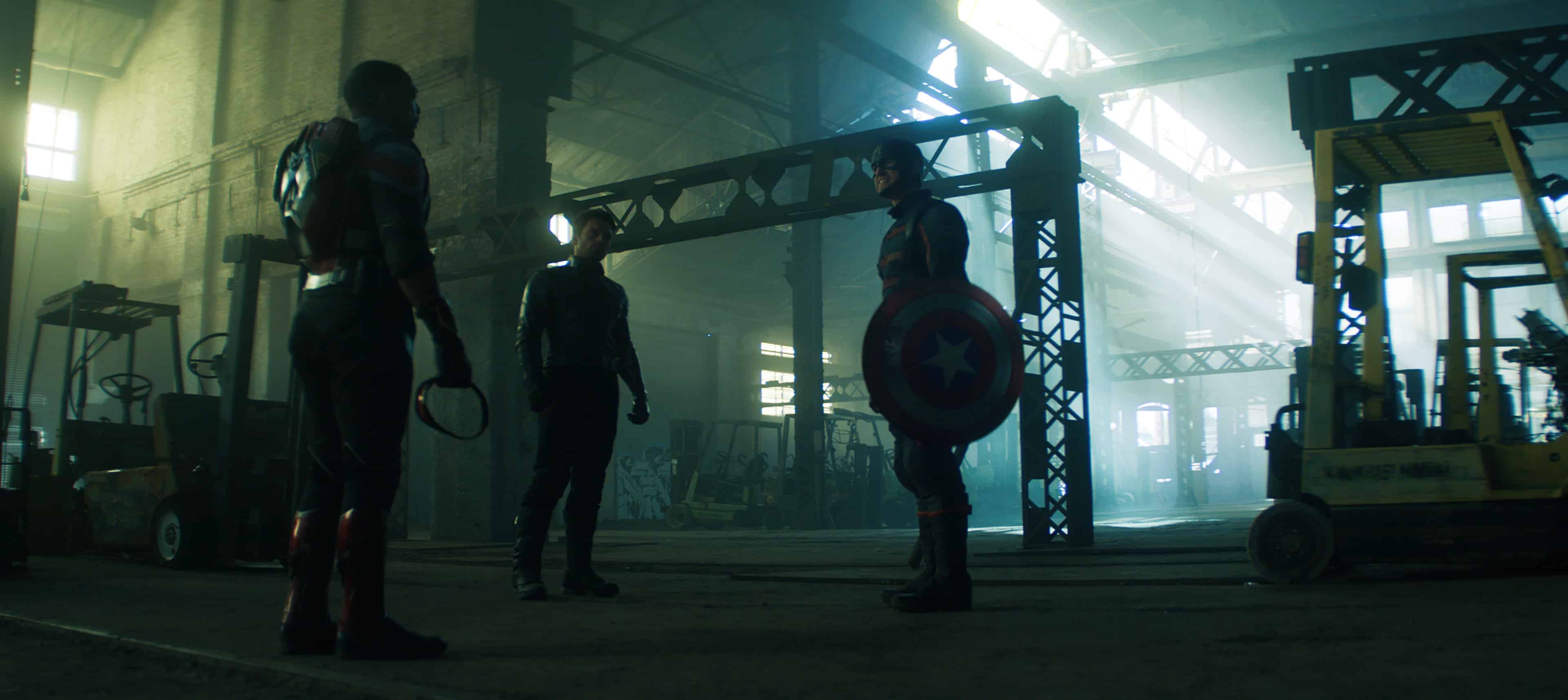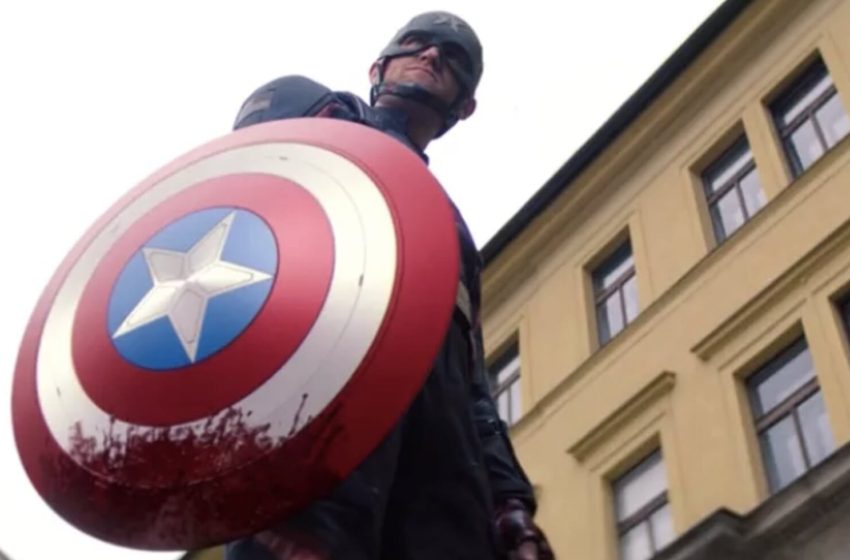WandaVision is over (and if you watched the show but haven’t checked out CXF’s coverage of it, you can do so here), but the seemingly-unending wheel of the Marvel Cinematic Universe continues to turn, bringing us the next Disney+ series, The Falcon and the Winter Soldier. Where WandaVision was positioned as something a little bit different than the usual MCU fare, concerning itself with delightfully-faithful pastiches of classic TV shows, The Falcon and the Winter Soldier, at initial glance, promises to be a series rendered more in the familiar style of the larger MCU (ie pretty people quipply performing militaristic action); whether that’s a good or bad thing is up to you. But assuming you’re going to watch, here are some things to watch for and keep in mind as you do, 29 fun facts about the two title characters culled from their rich histories.
Seven Captain America Sidekicks
With a few exceptions, Marvel Comics has never invested as heavily in sidekick characters, relative to their crosstown rivals at Detective Comics Comics. One of those exceptions is Captain America, who, thanks to his origins in the more sidekick-friendly Golden Age of Comics in the 1940s, has featured a series of sidekicks through the years.
Bucky

James Buchanan “Bucky” Barnes was the camp “mascot” (the army – at least the comic book one – is weird) at the military base where Steve Rogers pretended to be a befuddled private to main his secret identity; when Bucky discovers Rogers’ dual identity he blackmails him into letting him tag along as his sidekick, while later stories reveal that Bucky was in fact highly-trained and tasked by the army to carry out various clandestine missions, including assassinations, in support of Cap’s larger efforts.
Rick Jones

Marvel may not have had a lot of Silver Age sidekick characters, but that might have just been because they had Rick Jones, who basically served as everyone’s sidekick at one time or another. Introduced as the dumb teen who caused Bruce Banner to become the Hulk, Rick followed the Hulk to the Avengers, and when the Hulk’s brief tenure on the team ended, Rick stuck around, eventually attaching himself to a revived Captain America, who alternately loved & hated Rick for his resemblance to the believed-dead Bucky, alternating between refusing to train him and dressing him up in a Bucky costume.
Falcon

A social worker with a penchant for falconry, Sam Wilson first ran into Captain America on an island populated by exiles from Nazi Germany (Sam is working to help the natives fight off the Nazis), and helped him defeat an evil plot of the Red Skull’s. Impressed, Cap invites Falcon to be his crime-fighting partner, beginning a long association between the two characters (Cap’s comic book was even re-titled “Captain America and the Falcon” for a good stretch of time).
Demolition Man

A super-powered wrestler with a mask that makes him look like a muscle-y Wolverine, Dennis Dunphy worked alongside Steve Rogers during the time when he’d given up the Captain America identity and was operating as “the Captain”. Later, “D-Man” fell on hard times and ended up homeless. Later still, he settled into the unenviable role of “character who gets trotted out of character limbo to be used by a villain in order to exact a personal toll on the title hero”.
Jack Flag & Free Spirit

Embodiments of the early 90s as much as the American spirit, these two characters served as Cap’s sidekicks during the “the super soldier serum is killing him and he has to wear kewl 90s armor to function” era that capped off devoted Captain America fan Mark Gruenwald’s long run as the series’ writer
Nomad

Rikki Barnes is the Bucky to the poorly-drawn “Heroes Reborn” Captain America. A resident of the “counter-Earth” created by Franklin Richards to allow for the survival of the Marvel heroes seemingly killed by Onslaught and farmed out to Jim Lee & Rob Liefeld in 1996, Rikki eventually made the leap to the “real” Earth, using the name Nomad while fighting alongside other teen heroes.
Patriot

Not technically a sidekick to Steve Rogers, Elijah Bradley is the grandson of Isaiah Bradley, a black man who operated as Captain America following clandestine government experiments, as chronicled in the woefully out of print miniseries The Truth. After a blood transfusion gave Elijah a measure of Cap’s powers, he joined fellow teen superheroes with connections to legacy heroes (like the daughter of Ant-Man and the sons of Visions & Scarlet Witch) in founding the Young Avengers.
Four Replacement Caps
While Steve Rogers was the first Captain America (and all too often, the default Captain America), cycling him out of the mantle of Captain America and bestowing it on other characters (for a variety of reasons) is an evergreen Captain America trope in the comics, with both Falcon and the Winter Soldier’s title characters having assumed the mantle of Captain America in the comics at various times. Here then are some of the other characters who have wielded the shield through the years.
The Post-War Captains America

Created in 1941, Captain America was a star of the Golden Age, striking an especially relevant chord as America entered World War II. After the war ended, Captain America comics hung around, lasting well into the 50s (with a few retoolings to fit the popular genres of the times), before being cancelled in the face of decreasing demand for comic books. But when the Silver Age of Comics reinvigorated the demand for superheroes, Stan Lee dusted off Captain America for the new age, revealing that the character had been trapped in suspended animation since shortly before the end of the war. What, then, asked fans (especially fan-turned-writer and Golden Age aficionado Roy Thomas) of the Captain America & Bucky who operated in those post-war comics of the late 40s and 50s?
Enter the first batch of “replacement Captains America”, characters retconned into those old post-war Cap stories as having taken up the identity while the original was on ice. There’s William Naslund, who started out as the costumed Spirit of ‘76 before being asked by Harry Truman to assume the mantle of Captain America and was then killed by a robot who was trying to kill John F. Kennedy. He was replaced by Jeffrey Mace, the former superhero Patriot, who actually had a decent go of it in comic book terms, retiring in 1949 and living into his old age before dying of cancer. When Naslund retired, the government tapped William Burnside, a historian so obsessed with Captain America he changed his name to Steve Rogers. Injected with a wonky version of Cap’s super soldier serum & surgically altered to resemble Rogers, things didn’t end well for Burnside, who ended up going insane and becoming the Grand Director, the leader of a Neo-Nazi group and stooge of the Red Skull.
USAgent

In the mid-80s, the US government cottoned onto the idea that since they financed the development of the super soldier serum that gave Cap his powers and created his whole schtick, they owned, essentially, the intellectual property rights of Captain America. As such, they requested Steve Rogers cease operating as an independent agent and do the direct bidding of the US government. Rogers, declaring he serves the ideal of America rather than its specific government at any given time, refused, and gave up the mantle. At which point the government tapped John Walker, the Super-Patriot, to take over as Cap. The ensuing story, arguably the centerpiece of Mark Gruenwald’s long run, asks questions about what makes Captain America Captain America, as Walker struggles in the role, eventually leading to the return of Rogers and Walker assuming the USAgent identity.
Winter Soldier

In the wake of 2005’s Civil War (the miniseries which loosely inspired the Captain America movie by the same name), Steve Rogers, leader of the anti-registration factor whose surrender ended the eponymous superhero war, is assassinated on his way to trial. Believing the world still needs Captain America, Iron Man, the victorious leader of the pro-registration side, taps the recently-reformed Winter Soldier, Roger’s former sidekick, to take up the mantle. The former Bucky acquits himself reasonably well, but eventually gives up the role when Rogers returns from the dead (turns out he was just shot with time, not bullets) and Bucky is injured in battle.
Falcon

Sometime later, the revived Steve Rogers loses the age-retarding effects of the super-soldier serum, reducing him physically to the 80+ year old man he technically is. To keep the mantle of Captain America going, he taps his longtime ally Steve Wilson, the Falcon, to become Captain America. Wielding both his signature wings and the iconic shield, Wilson’s tenure taps into socio-political elements of Captain America more than any other (to varying degrees of success), though the ultimate execution of his tenure ends up marred by the larger “Secret Empire” event.
Five MCU Moments
“On Your Left”
Sam Wilson’s introduction to the MCU involves him being lapped by Steve Rogers as the pair jog around Washington DC, with Steve calling out “on your left” every time he races past Sam. This in turn leads to one of the most heartfelt callbacks in the MCU later as Steve, battered and his shield broken, faces off alone against Thanos in Avengers: Endagme, hears static on his earpiece, followed by “on your left” from Sam, who proceeds to fly in through a mystical portal, back from the dead and at the head of a massive army of Avengers to back Cap up.
The Highway Attack
The pinnacle of the Winter Soldier’s brainwashed villainy, the highway attack sequence is one Captain America: The Winter Soldier’s most intense fight scenes; it showcases the sheer brutality & unreletingness of the former Bucky while under the control of his Hydra masters, as he takes attack after attack from Cap, Black Widow, and Falcon, and just…keeps..coming.
Captain America vs. Winter Soldier
The emotional climax of Winter Soldier begins with Steve face-to-face with the brainwashed Bucky, begging him not to make them fight, and it ends with a beaten Steve refusing to give up on Bucky, his devotion eventually breaking through Winter Soldier’s programming. Because this is a Marvel movie, “emotional climax” means lots of punching, but it’s the relationship between Steve & Bucky which lands more effectively than all of their kicks, stabs, and shield-throws.
Car Bros
Steve Rogers romance with Sharon Carter is…problematic (being underdeveloped at best, and downright icky at the worst, given that she’s the niece of the woman he later abandons humanity to grow old with), but the culmination of their very low-key flirtations in Captain America: Civil War does allow for a humorous shared moment between the bickering Odd Couple of Falcon & Winter Soldier, as the pair, wedged into a VW bug, look on as their buddy finally acts on his feelings.
“Oh, I’ll get that arm…”
It’s a brief moment, but the interaction between Winter Soldier and Rocket Raccoon (who has an established predilection for both cool guns and cybernetic body parts) when the pair first meet on the Wakandan battlefield of Avengers: Infinity War is a testament to that film’s ability to tap into the goofy charm of superhero team-ups, and creates a brief moment of levity just as things are getting increasingly dire for the heroes.
Five Potential Villains
Across three Captain America movies, a number of notable Cap villains have been featured, many of whom are off the table now (e.g. Crossbones [exploded] and Arnim Zola [transformed into a computer & exploded]). A couple pre-existing villains are slated to return in Falcon and the Winter Soldier (including Winter Soldier’s first level badguy Batroc ze Leaper and Civil War’s unnecessarily-Machiavellian Zemo); here are a few more who might make the jump to the MCU.
Dr. Faustus

An evil psychiatrist with extreme hypnosis abilities, Faustus is a fairly normal looking dude with a wild beard whose biggest act of villainy is probably his role in the post-”Civil War” death of Steve Rogers.
Serpent Society

Marvel has a bunch of snake-themed villains running around; the Serpent Society brings them all together in a riff on the 80s Wall Street/corporate America “greed is good” mentality, in which this assortment of villains with gimmicky snake weapons & powers are run more like a business than a super-villain team.
Flag Smasher

An anti-patriotic quasi-anarchist who hates the concept of nations (created, perhaps a bit too-on-the-nose, by Mark Gruenwald to be a sort of counter-Red Skull Captain America villain), Flag Smasher deserves credit for having his chief weapon of choice being the very-on-the-nose spiked mace (the better to, you know, smash flags with).
Sin

While the MCU’s version of Red Skull might be trapped as a weird floaty phantom on a planet housing the Soul stone, there’s room for his comic book daughter (Sinthea Schmidt aka Sin) to make the leap to the small screen and inherit her father’s mantle. In the comics, Sin’s biggest accomplish probably comes in the form of “Fear Itself”, one of Marvel’s yearly events in which she led a group of villains possessed by mad Asgardian gods in an all-out assault on the world and (briefly) killed the Winter Soldier when he was operating as Captain America.
MODOK

Or, Mental Organism Designed Only For Killing, MODOK is a big giant head with mental powers who hates Captain America because he’s so hunky. Fingers crossed he makes it to the MCU!
Eight Notable Issues
Avengers #4

This issue is notable for bringing back the original Captain America and establishing the whole “trapped in ice” thing (as well as introducing the “Asparagus People” aliens against whom Dark Phoenix will later commit a genocide; Silver Age comics are wild, y’all). But it’s also notable for establishing that Cap’s sidekick Bucky, the future Winter Soldier, didn’t survive the war, and died at the same time Cap got frozen. This led to numerous Silver Age stories in which Cap angsts about the death of Bucky, but more importantly, also served as the foundation for one of the seemingly inviolate laws of superhero comics: other characters might die and come back and die again, but Bucky stays dead.
Captain America #117

Sam Wilson makes his first appearance as the Falcon, and with it, comics gets its first African-American superhero.
Captain America #170

Despite the name, Falcon didn’t actually fly for much of the early days of his partnership with Captain America (the name was inspired by the fact that he had a psychic connection with a falcon named Redwing, forged by Red Skull using the Cosmic Cube, because the Silver Age). That changed with this issue, as Black Panther creates a high-tech harness that finally lets the Falcon better emulate his namesake; it will be a staple of the character from that point forward.
Avengers #181

When the US Government started exerting control over the Avengers, they mandated a streamlined roster stocked with members chosen by them (or at least their representative, the unctuous Henry Peter Gyrich), including first-time Avenger Falcon, who is placed on the roster in an attempt to add diversity to the mix. Falcon bristled at this act of what he views as tokenism, and quits as soon as he is able. Eventually, he will return to the team, but on his own terms.
Falcon #2

After Marvel began experimenting with limited series in the early 80s, Falcon was one of the characters tapped to be featured in the relatively new format. In issue #2 of that series, Falcon is revealed to be a mutant, with the ability to telepathically communicate with all birds, not just Redwing. Though this will later be re-retconned (Falcon is not currently considered to be a mutant today, his bird telepathy powers considered an extension of that initial bond with Redwing created by Red Skull), but for most of the 80s & 90s (aka the zenith of the X-Men’s popularity & commercial prowess), Falcon was one of those mutants all the kids loved.
Captain America (vol. 5) #6

Ed Brubaker’s “Winter Soldier” arc officially begins with the first issue of this volume, kicking off what will become a seminal run on Captain America with penciler Steve Epting. But it is issue #6 which reveals the identity of the Winter Soldier, confirming he is Bucky, who didn’t die after all. By realizing there was a better story to tell with a living Bucky than a dead one, Brubaker upends decades of comic book “law”
Captain America (vol. 5) #34

After Steve Rogers is killed in the wake of “Civil War”, this issue sees the debut of Bucky as the new Captain America, following in the footsteps of his dead (at the moment) friend to honor his memory.
Captain America (vol. 7) #25

Long overdue for a promotion, Sam Wilson takes on the mantle of Captain America for himself.
The Falcon and the Winter Soldier premieres on Disney+ March 19. Follow CXF’s coverage of the show, from Kenneth Laster (and friends), here.
Austin Gorton also reviews older issues of X-Men at the Real Gentlemen of Leisure website, co-hosts the A Very Special episode podcast, and likes Star Wars. He lives outside Minneapolis, where sometimes, it is not cold. Follow him @austingorton.bsky.social.






